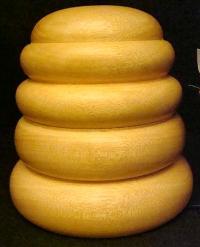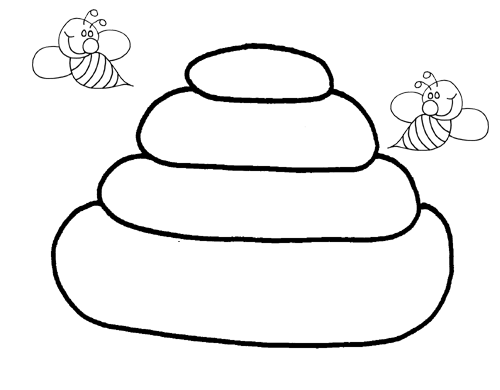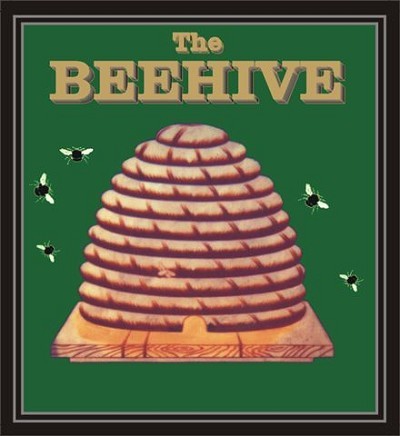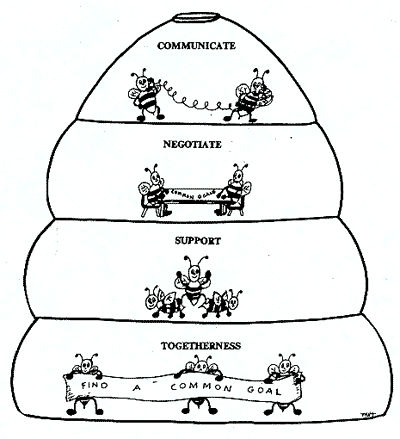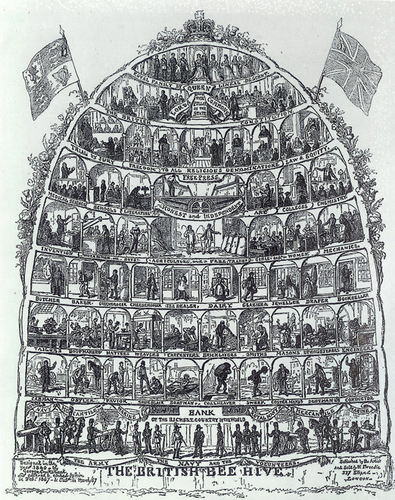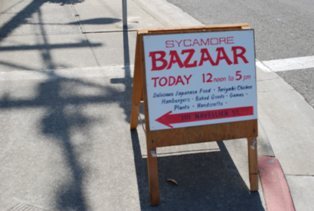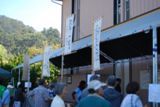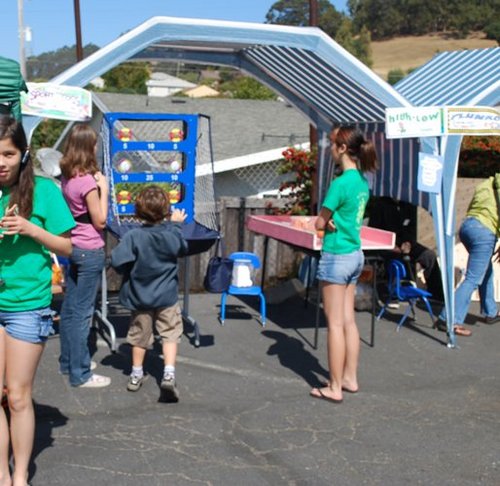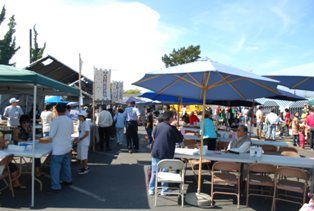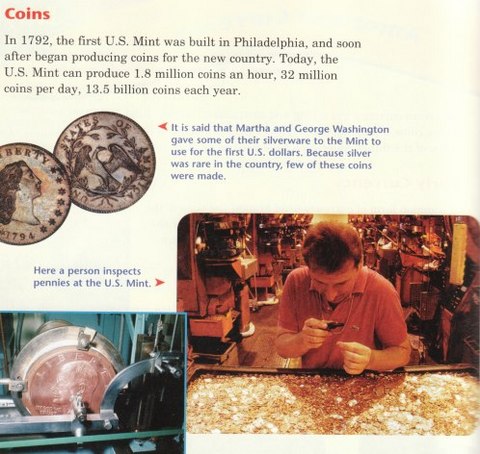April 21 英語の勉強 ELD [小学校と銀行]
April 21, 2008 (Monday) -
モーリちゃんは日本では英語の勉強はほぼまったくしなかったので、当然のことながらELDという英語の補習授業に出ることになった。これは週に4回ある(月、火、木、金の1時間ずつ)。4月の最初のころ、英語の母音と子音の発音の勉強から始まった。母音字と子音字の勉強も一緒だった、というか、音(sound)が必ずしも文字と対応するわけではないのだから、音声学的にはアバウトなような気もしたが、ともかく始まった。そのときのプリントが見つからない(もしかして提出してしまったのだろうか?)ので、正確な記述ができないので、それはまた今度にして、ちょっとだけエピソードを。
問題のパタンのひとつに、四つ絵が描いてあって、同じ音(おん)をもつのを選んで、その単語を書く、というのがあった。絵は一度だけでなく、いろいろな組み合わせで繰り返し出てくる。そのなかで、これなんだろう、あるいは、これなんていうんだろう、というのがいくつかあった。後者の、これ英語でなんていうんだろうというのは、たとえば「らっぱ」= bugle とか・・・・・・あ、いま『ジーニアス』を見たら、dagger (剣)のマークがついてました。凡例の見方がわからないのですが、学校で教わる単語に入っているのかしら。でもモーリちゃんの父は中高で教わった記憶がありません〈汗)。まあ、ポップスとかで(Andrews Sisters, "Boogie Woogie Bugle Boy")若いころから言葉は知っていましたが、そんな日常的な言葉という感じがなかった。
絵自体がなんだかわからなかったののひとつがこれです。こんなやつ――
それで、なんだろう、なんだろう、と3人で頭を悩ませたのですが、モーリちゃんの母は、途中から、「これはうんちだよ、dung, dung! 」と唱えだしました。でもモーリちゃんは、「なんか穴があいてるし、違うよ」と言い、モーリちゃんの父も、まさかうんこを出さんだろう、と考えるぐらいの常識はもちあわせておったのですが、はた、とひらめいて画像検索をしたら出てきたのでした、似たようなのが。
同じものを描いたのでもっと「リアル」なのをあげると、これかな――
これとかも――
絵に描かれる場合もけっこうあるようです――
はい、みつばちの巣、beehive なのでした。
看板にもなっています――
Robe and Bee Home: Welcome to the BeeHive
〈よっつくらい上の "beeautiful" と同様というか、上のほうが苦しいですが、be = bee のしゃれ)
candle にも――
hairdo にも――
 Marge Simpson and Amy Warehouse
Marge Simpson and Amy Warehouse
日本だとアリかもしれませんが、ミツバチは勤勉と協働のシンボルなんでしょうか――
イギリスでは「女王」を頂点とする体制のヒユとしても使われたようです――
秘密結社フリーメイソンでもbeehive の象徴があると書いているサイトがあった――
William Bond, "Woman Thou Art God: Goddess Symbolism Within Freemasonry" <http://www.womanthouartgod.com/wmbondfreemasonry.php>
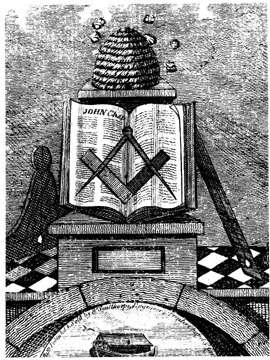 The Three Great Lights in Masonry
The Three Great Lights in Masonry
The beehive is another popular Freemasonry image. I am sure they will tell you that the beehive is a symbol of people working together industrially for the good of the whole. So it would represent hard work and good organization.
Yet again it would be another very good Goddess symbol. The beehive is ruled by the Queen bee and the worker bees are also female. The male bees are the drones, who have no role except to fertilize the Queen bee. The drones who are not used in this way are surplus to requirements and are killed by the worker bees. So it means that the beehive is in fact a Matriarchal Society. Which seems to be a strange symbol for what is suppose[d] to be a male dominated organization.
Bees in Ancient times was the symbol of the Goddess Artemis. This was because she was once the Great Mother who created the world without the help of a male God. The ancients believed that bees created themselves through parthenogenesis, so bees became a symbol of the Virgin Creatrix Mother. Who has survived in Christianity in the personage of the Virgin Mary. She is called by the Roman Catholics, "The Mother of God" which comes from a pre-Christian saying that the Great Mother is the, "Mother of all Gods".
Some people have also claimed that the bee hive represents the pregnant belly of the Great Mother. In much the same way that the artificial Neolithic Silbury Hill in England is claimed to be, "the swollen pregnant belly of the Earth Mother." Images of pregnant Goddesses are found in Palaeolithic and Neolithic sites.
beehive は全体のために共に働く人々〈人民)の象徴であり、勤勉と秩序だった機構をあらわす。がまた女神の象徴でもある。巣を統治するのは女王バチで、働きバチも女性、オスのハチは巣にいて働かないのらくら者だ。・・・・・・beehiveは女権社会である。ならば〔フリーメイソンという〕男性中心の組織の象徴としては奇妙に思われる。古代ギリシアのミツバチはアルテミス女神の象徴だったが、それはアルテミスが男神の助けを借りずに世界を創造したからだ。古代人はミツバチは単為生殖〔parathenogenesis = 処女受胎〕で増殖すると考えた。だからミツバチは処女=創造者=母の象徴となった。それがキリスト教では処女マリアにつながる。カトリックでマリアは「神の母」の尊称を与えられているが、それは大地母神は「すべての神々の母」であるというキリスト教以前の考えから来ている。beehive が地母神の多産の腹をあらわすと主張する人たちもいた。〔概略訳で以下略〕
けど、フリーメイソンも実は古代に由来するのではなくて近代英国の産物なのだとすれば、イギリスの体制がダブっているのかも。
おお、話がうんこから思弁的なところへ展開してしまった。展開と言えば、モーリちゃんの母は、「とぐろ巻いてるしー」と言っていたが、ヘビのようなとぐろは宇宙をあらわしているということもあるかもしらんな(ねーよ)。
(日本ブログ村へ)
----------
参考URL
カリフォルニアの小学校のELD (English Language Development) プログラムについては、HOLIDAY SEASON さんの 「学校」のページがとてもていねいに説明なさっています。<http://www.geocities.co.jp/HeartLand-Gaien/9453/school.html>
Veronica Mihalopoulos, "Beehives, Bouffants and Big Big Hair" <http://www.begoths.com/gothic-fashion-chicks.php> 〔goth fashion dolls-teen trends-medieval〕
"The beehive is back - and it's better than ever | Mail Online" <http://www.dailymail.co.uk/femail/article-484845/The-beehive--better-ever.html> 〔イギリス 2007〕
"Beth's Illustrator 1 Lesson 2 Homework" <http://blovejoy.com/illustrator1lesson2.html> 〔サカサbeehive〕
"Welcome to BeeHive Day Spa" <http://www.beehivedayspa.com/index.html> 〔ワシントンのスパ〕
"Osglim Beehive Neon Lighting Lamp" <http://www.lamptech.co.uk/Spec%20Sheets/Osglim%20Beehive.htm> 〔GEC の電球〕
William Bond, "Woman Thou Art God: Goddess Symbolism Within Freemasonry" <http://www.womanthouartgod.com/wmbondfreemasonry.php>
June 13 つうしんぼ Grade Report Card [小学校と銀行]
June 13, 2008 (Friday)
この日で小学校は長い夏休みに入る。2007-2008年度の終了の日。モーリちゃんは学校から親宛ての封筒に入った先生からの手紙をもらって帰ってきた。つうしんぼ。とひらがなで書くと、さびしんぼのようなしみじみしたものがある(ない)。 2か月も通っていないし、EL (English Learner) として別のクラスに参加しているし、ふだんは教室でひとりで絵を描いているそうだから、期待もなにもないし、ただモーリちゃんが落ち込まねばよいが、とは思っていたのですが、"Standards Rublic" (基準の説明)と上に注釈があって "4 - Meeting Standard - Goal is to reach this level by Period 3. The student regularly demonstrates mastery of and applies key concepts, processes and skills. The student has met the grade level standard. /3 - Approching Standard The student is making progress towards meeting the grade level standard. /2 - Making Progress/Below Standard The student is demonstrating some understanding of key concepts, processes, and skills and may require additional time and support. /1 - Below Standard The student does not yet demonstrate understanding of key concepts, processes and skills, and requires additional time and support. /N/A - Not Assessed This standard has not been assessed or introduced this period. /EL - English Learner Please refer to ELD benchmarks (attached)" と4段階評価とその他(モーリちゃんはELだけど、別紙はなくて、ここの項目が丸で囲まれていて☆印がついていて、下の通信簿の該当箇所に☆が記入されていた)。
で、Mathematics の "Reads and writes whole numbers to the millions" (百万までの数字を読み書きする) と"interpretes and solves word problems" (記述問題を解釈し解く)みたいなのは2でしたが(後者についてはモーリちゃんの父も宿題を見て頭を悩ませた)意外と3をもらっていて、足し算引き算は4だった(まあ、日本で既にやっていたからな)。1はいただかなかった。ありがたいことです。
それと、モーリちゃんたちよりちょっと前に学校に入って、もうすぐ別の土地へ去っていくアーニャのおかあさんによると、これははじめてのことだという話ですが、つうしんぼとは別に、生徒同士が評価をしあったのをまとめてタイプしたきれいなA4の紙が1枚一緒に入っていました。モーリちゃんはこんなの書いていない、と言っていましたが、キミの出ていない国語の時間とかに書いたんだよ、たぶん。記念に書き写しておこうと思います。Mori Mori 。。。
polite to me and everyone
thank you for the friendship that we built
a determined soul/very kind
you are really friendly
you have an interesting personality
is a good English learner because she tries hard
a great drawer
a good kind person
a very generous person to share candy and you are cute as a button
quiet and fast learner
very kind and respectful
is love
is kind because she lets me borrow her stuff
you're very sweet because you always share
you're improving on you English, I can understand you now
thank you for the pencil
you're a good friend because you give me cards and you are nice to me
is a smart girl
silently smart
you're a good friend because you are kind and caring
friendly and beautiful
a kind girl to teach.
ありがたいことです。
感謝とともに
June 23 サマースクール Summer School [小学校と銀行]
June 23, 2008 (Monday)
モーリちゃんの小学校は6月13日の金曜日に終業して、8月末までの夏休みに入ったのだけれど、今日から7月18日までのサマースクールがはじまった。Summer School Office というところから(そんなのがいつできていたのかしら、と思ったら同じAlbany Unified School District からなのだけれど)の4月18日付の文書を6月の頭に渡されて、署名するように求められた。"Dear Parents,/Your child has been recommended by his/her teacher to participate in summer school. The elementary summer school will include an intensive program with instruction in reading, writing and mathematics. The program is intended to address the needs of current 1st through 5th grade students who have not yet met grade level standards in one or more areas." ということで WHEN, WHERE, HOURS (Monday - Friday 8:20 - 12: 30) が記載されていて、そのあと "Please noe that students are expected to attend class for the entire 4 week program (19 days). Daily attendance is crucial for your student's learning and attendance will be taken daily. 〔ここ英語がちょっとヘンな感じがする〕Students with more than 3 absences will be dropped from the program." 段落"Please return the attached registration form to your child's school by Friday, May 2nd. Applications received after that date will be processed and students assigned as space is available." 段落 "We look forward to working and learning with you and your child this summer." 段落 "AGAIN, THANK YOU FOR RETURNING THIS TO YOUR CHILD'S SCHOOL OFFICE BY MAY 2ND." 段落 "Sincerely,/W---- H----/Summer School Elementary Principal" で、別紙が "ALBANY UNIFIED SCHOOL DISTRICT Summer School, 2008 ~ Intervention/Remediation Registration for Elementary Students currently in 1st - 5th grades June 23 to July 18, 2008" というタイトルの文書で、四角で囲ってこんなふうに書かれていました。
あなたのお子さんはサマースクールに参加することが薦められています。今年のサマースクールの授業は読書能力、言語科目、算数の年次の水準にまだ達していない生徒の必要にこたえるものです。(Your child has been recommended to participate in summer school. This year's summer school program will address the needs of those students who have not yet met grade level standards in reading, language arts or math") (段落)申し込むすべての生徒を受け入れられない可能性があります。ですからこの登録フォームに記入して5月2日金曜日までに学校の事務に戻すことが大切です。(Room may not be available for all students who apply. Therefore it is critical that you complete this registration form and return it to the school secretary by Friday, May 2nd"(段落) 私は私の子供が4週間のサマースクール全期間に通わねばならないことを理解します。3日以上彼(女)が欠席した場合は、彼(女)はサマースクールから放校となります。(I UNDERSTAND THAT MY CHILD MUST ATTEND ALL 4 WEEKS OF SUMMER SCHOOL. If s/he misses more that[sic than] 3 days, s/he will be dropped from Summer School. )〔署名欄 Parent/Guardian signature (required for admission)〕
そのあと、"STUDENT NAME," "SEX," "BIRTHDATE," "SCHOOL" 〔Albanyの3つの小学校合同なので〕, "TEACHER," "ADDRESS," "HOME PHONE," "Afterschool daycare provider," "PHONE NUMBER," "STUDENT LIVES WITH: ADULT'S NAME__RELATIONSHIP___Cell Phone:___ Work Phone:___," "ADULT'S NAME__RELATIONSHIP___Cell Phone:___ Work Phone:___," "If parent or guardian cannot be contacted: NAME___ Phone___ NAME___ PHONE," "If your child has an on-going and/current medical problem, or is taking a prescription drug, which must be administered, at school, by school personnel, please indicate here and give details: _______________ DOCTOR'S NAME______________ PHONE_________," "If an accident or emergency occurs and either parent:guardian cannot be contacted, I authorize school personnel to arrange transportation, by ambulance, for my child appropriate medical treatment at my expense. _____INITIAL," "WALKING PERMIT Your signature below indicates approval for your child to go on walking trips throughout the summer. ___________ Parent/Guardian Signature," "OFFICE USE ONLY: Date Received: _________ FOR MORE INFORMATION: W--- H---, Elementary Summer School Principal, District Office, 904 Talbot Avenue, Albany, CA 94706, 5XX-37XX."
ということで締め切りが5月2日だった文書だったのですが、両親とも同一の自宅電話番号だけで勤め先の電話番号なし(まあ書いてもよいのだがメーリさんにかけられてもなあ)、携帯電話なし、かかりつけの医者なし、でモーリちゃんの父が署名して提出したのが6月7日だったと思います。モーリちゃんの場合はもちろんlanguage arts の英語の補講みたいなものです。
4月18日というとちょうどモーリちゃんが小学校に通いだした日です。まあ、担任の先生も最初からわかっていたけれど追加で出してもだいじょーぶと考えてタイミングをはかっていたのかもしれません。モーリちゃんの父たちも夏の補習のことは耳にしていたけれどもだいじょーぶと考えていたような。まあカリフォルニア時間みたいな(笑)
ところで前々日まで忘れていたのですけど、モーリちゃんの母がadult schoolに通いだしたので、モーリちゃんをモーリちゃんの父が毎朝送っていくことになったのでした。
それで、ひさしぶりに、というか二人で行くのは初めてですが、モーリちゃんの父とモーリちゃんは通りに出たところでモーリちゃんの母と別れて、ふたりで小学校へ早足で向かいました。
入ってすぐのところの壁に生徒の氏名と教室番号、担当の先生の名前を記した表が貼りだしてあったので、モーリちゃんの父が確認してモーリちゃんに伝えました。 「なんか、プレイグラウンドに集まって先生と会いましょうって。」 15番は知らない教室だというので、時間もあったので、どこか探そうかとふらふらしていたら、知らない女の人が近づいてきて学校のことを訊かれたので、(最初モーリちゃんが訊かれて、わかる? みたいな感じだったので、英語の勉強に来てるのにわかるかい、と思ったのですが、そうか、英語だけじゃないのだな。それと別の小学校から来ている生徒たちがいるのです)「いやあ、娘は英語がわからんからimproveするために今日から授業が始まるんす。え、ぼく? ぼく生徒じゃないし知りません。ソーリー」というような主旨で答えて逃げました。プレイグラウンドに出たら100人近くの親子が集まっていて、前のほうに部屋番号と教師名を書いた先生が3人ぐらい立っていました。けれどもモーリちゃんの先生もモーリちゃんの知っている生徒も見当たりません。そのうち担当の先生がふだんELDを教わっている先生だということを聞かされました。(なんだよ、早く言えよ)。ようやく知っている少年がいたので話しかけると、彼も同じ教室なのだが、わからない、という答えでした。モーリちゃんの父が背伸びをしてうかがっていると、15番のカードをもった女の先生が出てきたので、「あ、来たよ」とふたりに告げました。モーリちゃんは、「モー帰っていいよ」というので、ほんとうは校長のあいさつでも聞いてやろうかと思っていたモーリちゃんの父でしたが、すごすごと小学校をあとにしました。
で、San Pabloをずっと北へ歩いて、Solanoを横切ってさらに10分くらい歩いてEl Cerrito Plaza のモールに行ったら、Trader Joe's は9時からでまだ15分も時間があったので、まず一服してから、先にLongs Drugs に入ってチョコとビールとパスタなどを買い、それから9時ちょうどにTrader Joe'sに入ってハマスとクラッカーとスープ(これはパスタソースのもとにしようと思っている)とチーズを買って、"Have a good day♪” といつもの挨拶を受けて帰宅しました。どちらの店もレジに店員が少なかったのですが、ドラッグストアのほうはおばちゃん(なつきまりのアメリカのおばさん、とモーリちゃんの父が勝手に思っているほうではないほう)一人だけでした。その人がなんかの用事でレジを離れているときにモーリちゃんの父はレジにむかったのですが、だいぶ年配のおじいさんが親切に、「おそらくこっちのレジのほうで会計だと思いますよ」と教えてくれました。オーサンキューとしか言えなかったけれど、もっと気のきいたことを言えばよかったろうか、いやそんなことはない。
通りから家の入口に通じる坂道のドライヴウェーをあがっていくと、門から人が出てきて、ちかづくと、どこかで見た顔。あ、と思うより前にむこうが左手を大きくあげて、すれちがいました。このあいだガスケットの交換に来た男の人でした。
September 1 算数の勉強 (1) Math Practice (1) [小学校と銀行]
September 01, 2008 (Monday)
モーリちゃんの学校が28日から始まって、数か月ぶりにまた算数の英語、もしくは英語の算数、の世界にモーリちゃんの父もツカリソウな予感の連休です。
以下、数学が苦手な文系の人は読んだら楽しいかもw。
Fifth Grade Everyday Mathematics という、シカゴ大学の "Universtiy of Chicago School Mathematics Project" (UCSMP) が開発した教材を使うのだそうだが、それの "Study Link 1-1" の "Unit 1: Family Letter" という、3ページにわたるプリントを金曜日に持ち帰ってきました。 1ページ目の最後のところには太字で "Please keepthis Family Letter for reference as your child works through Unit 1." と書かれており、おいおい、親を巻き込んで勉強かい、やっぱり、という感じなのでした。
1-2ページの途中まではこの教材のねらいと特長が書かれているのですが、そのあといきなり "Unit 1: Number Theory" の解説に突入。ページ下のコラムには "Building Skills through Game" というのがあり、UNIT 1 では"Factor Bingo" "Factor Captor" "Multiplication Top-It" "Name That Number" という4つのゲームを楽しんで計算を学んだりもするのだそうで、ふたつめの "Factor Captor"――因数捕獲?――の説明は "See Student Reference Book, page 306. This is a game for 2 players. Materials needed include a Factor Captor Grid 〔因数捕獲碁盤?〕, 48 counters the size of a penny 〔1仙玉サイズの48個の石というかカウンター〕, scratch paper 〔メモ用紙のことですね〕, and a calculator. The goal of the game is to strengthen the skill of finding the factors of a number." と書かれていますが、何をどうするのか実はわかりません。Student Reference Book の306ページを見ろ、と書かれてますけれど、教科書は小学校に置いたままです(それに日本と違って自分のものにはならず借りているので・・・・・・あ、いまモーリちゃんたちと話をしたのですが、こちらに前から住んでる人の話だと社会の本を、古いのを家用にくれた先生がいたそうな・・・・・・去年の話だとみんな教室で終わったところはちぎったりしているようで・・・・・・でもモーリちゃんはそんなことはもったいなくてできないから最後にもらってきたとか・・・・・・よくわからんです)。
あとはVocabulary。composite number A counting number greater than 1 that has more than two factors. For example, 4 is a composite number because it has three factors: 1, 2, and 4. 〔"composite number" は「合成数」と訳されてますけど、そんな言葉でモーリちゃんの父は習っていない気がする。「2以上」は "more than two" で、「1より大きい」が "greater than 1" ですか。整数の場合だと同じだけれど。"counting number" = 自然数(ゼロ以外の正の整数)〕 divisible by If the larger of two counting numbers can be divided by the smaller with no remainder, then the larger is divisible by the smaller. For example, 28 is divisible by 7 because 28 / 7 =4 with no remainder. 〔「割り切れる」ということですね。"remainder" = 余り〕 exponent The small, raised number in exponential notation that tells how many times the base is used as a factor. 〔"raise" 自体が累乗するという意味だと思うし"exponential notation" (これ辞書に出てこないのですが「累乗(法)」 =exponentiation という日本語に相当するのでしょうか)というフレーズが説明に入っているのも辞書的には純粋じゃないのですが(辞書じゃないって)、"exponent" は累乗の指数、「ベキ」ですね〕 factor One of two or more numbers that are multiplied to give a product. 〔因数〕 factor rainbow A way to show factor pairs in a list of all the factors of a number. A factor rainbow can be used to check whether a list of factors is correct. 〔対の約数を結んだ弓形というか虹の形の弧のことらしい。見たような見てないような・・・・・・こんなやつ――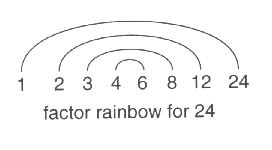 〕 number model A number sentence or expression that models a number story or situation. 〔計算式、数式〕 prime number A whole number that has exactly two factors: itself and 1. For example, 5 is a prime number because its only factors are 5 and 1. 〔素数。 "whole number" = 整数 (integer)、自然数〕 product The result of multiplying two or more numbers, called factors. 〔積〕 rectangular array A rectangular arrangement of objects in rows and columns such that each row has the same number of objects and each column has the same number of objects. 〔これは方陣とか訳すのかしら。単なる行列というのではないような。matrix ですけど。こんなやつ――
〕 number model A number sentence or expression that models a number story or situation. 〔計算式、数式〕 prime number A whole number that has exactly two factors: itself and 1. For example, 5 is a prime number because its only factors are 5 and 1. 〔素数。 "whole number" = 整数 (integer)、自然数〕 product The result of multiplying two or more numbers, called factors. 〔積〕 rectangular array A rectangular arrangement of objects in rows and columns such that each row has the same number of objects and each column has the same number of objects. 〔これは方陣とか訳すのかしら。単なる行列というのではないような。matrix ですけど。こんなやつ―― "row" は「行」で "column" は「列」で〕、そういえばラインダンスのラインをイギリス英語では "row" と呼ぶのだった、と思いだしましたが、数学ではアメリカでもrow なのですね(lineは別に指すものがあるからかなあ)。それでも rowやline はやっぱり本来横並びなのでしょうね。日本語では「行」と「列」という言葉より「横列」「縦列」という呼び方が今は一般的のようですが、そうなると何が行で何が列かわからなくなりますね。でも文章のラインは「行」と訳されているわけで、縦(書き)でも行と呼んでいたのか、それとも訳なのか――うはっ、すごい脱線w〕 square number A number that is the product of a counting number multiplied by itself. For example 25 is a square number, because 25 = 5 * 5. 〔乗数〕
"row" は「行」で "column" は「列」で〕、そういえばラインダンスのラインをイギリス英語では "row" と呼ぶのだった、と思いだしましたが、数学ではアメリカでもrow なのですね(lineは別に指すものがあるからかなあ)。それでも rowやline はやっぱり本来横並びなのでしょうね。日本語では「行」と「列」という言葉より「横列」「縦列」という呼び方が今は一般的のようですが、そうなると何が行で何が列かわからなくなりますね。でも文章のラインは「行」と訳されているわけで、縦(書き)でも行と呼んでいたのか、それとも訳なのか――うはっ、すごい脱線w〕 square number A number that is the product of a counting number multiplied by itself. For example 25 is a square number, because 25 = 5 * 5. 〔乗数〕
よく、ヨーロッパの言葉では、日常の語彙がそのまま専門的な用語となっている、というようなことが言われますけれど、なんか、そういえばそうかもしれん語とそうではなくてえらく専門的な響きのある語が混然となって、とてもモーリちゃんの父は混乱しています。日本語に直さないでそのまま考えろ、と言われても考えられんよ。なんで exponent がベキ指数なのか、あるいは、ここにはあがってないけれど "mixed number" がなんで帯分数なのか、あるいは "improper fraction" がなんで仮分数なのか、わけがわかりませんわ。こゆうので論理的な思考とやらが育まれるのでしょうか。
factors はmultiply されると product を生じる。なんで足し算ではproduct でも factor でもないのでしょうか。あるfactor に別のfactor がかけあわさってひとつの情況ができる。あるfactor に別のfactor が加わって別の情況ができる、とはならないのね。英英辞典での日常世界でのfactor の意味―― "one of several things that influence or cause a situation: The rise in crime is mainly due to social and economic factors. The weather could be a factor in tommorow's game." ううむ、かけあわさって、というのが英語的意識なのかなあ。Susanna's support was a key factor in Foster's election win. スザンナの支持はフォスターの選挙の勝利の鍵となるファクター〔因数・要素〕だった。あるいは分数とか小数ではfactor にならないのはなぜだろう。3 is a factor of 15. 3 (factor) x 5 (factor) = 15 (product). 1.5 x 10 = 15 (product?) Product is "the result of multiplying two or more numbers, called factors." Then those given "numbers" are already whole numbers? あるいは、削ったり少なくしたり割ったりすることで生まれるproduct というものはないのでしょうか(算数の世界の話だから、といわれれば、それまでのようでいて、それまでのようではない。だったら算数の世界にふつうの言葉を持ち込むなよ、といいたく(も)なるわけです)。
いっぽう、じっさいに教室でやらされたらしい "5th Grade Mountain Math" というプリントを見ると、 1. Write this number. / 1. Is this number even or odd? / 1. Round this number to the nearest 10. / 1. Round this number to the nearest 100. / 1. Round this number to the nearest 1,000. / 1. Round this number to the nearest 10,000. / 1. What is 100 less than this number? / 1. What is 100 more than this number? / 1. What is 1000 less than this number? / 1. What is 1000 more than this number? / 1. Write in expanded notation? / 2. Write this number. / 3. What is this numeral? / 4. Write the numbers. What is the place value of the top digit in each number? . . . . 以下エンエンとw
はっきり言ってわからんす。たぶん "this number" なるものを黒板に書くなりなんなりして始まると思うのですが、かりに12345という数が提示されたとして、最初の偶数か奇数かはいい。だけどそのつぎからの、"Round" で始まる問い、この「丸める」(という言葉をモーリちゃんの母は知っていたように語っていたがモーリちゃんの父はそんな言葉は聞いたことがなかったですけど)というのは概数を出せということですけど、 "to the nearest 10" というのは「10の桁までであらわすとおよそいくらか」みたいなことですかね。12350。だけどなんで "to the nearest 10" がそういう意味になるのでしょう。"more than" "less than" は慣用句的発想を禁じれば問題ないですが。4番のなんかは、まあ確かに "place value" =けた (これ[=けた]は、いちおうネット上で参考になる "English as a Second Language Programs: Math Vacabulary English--Japanese--" [Ann Arbor Public Schools Instructiona Services] の訳ですが) というより言葉に立ち返って、その桁にあることで持っている価値、という考えでわかるのだけれど、しかし・・・・・・むつかしい。 むつかしすぎる。わしでもついていけないと思います。
それで、しょうがないから、しかし貧乏根性でネット上でなんか参考になるものを探しました。 探すときに気になっていたのが分数だったので、とりあえず、
Watch Video on Reducing Fractions - Lowest Terms -
これのFree Video はきれいなおねえさんが 30/75 の通分の説明をしてくれます。だけどなあ、common mistake が最大公倍数いや公約数を5と考えることで、ほんとは15、だから15で割ってみたいな説明だけれど、通分の過程としては5で割るのがあるのが自然なような気もしますが・・・・・・。
Students learn that a fraction is in lowest terms if the Greatest Common Factor of the numerator and denominator is 1. For example, 3/5 is in lowest terms, because the Greatest Common Factor of 3 and 5 is 1. However, 3/6 is not in lowest terms, because the Greatest Common Factor of 3 and 6 is 3. Students also learn that a fraction can be rewritten in lowest terms by dividing the numerator and denominator by their Greatest Common Factor. For example, to write 10/15 in lowest terms, divide the numerator and denominator by their Greatest Common Factor of 5, to get 2/3.
で、あれこれ探しているうちに、Ms. Crawford 先生の部屋(Ms.Crawford's Room) に行きつき、クローフォードさんのブログは文字化けもあったりして消化不能だったけれども、さまざまなリンクがあり、そのなかにちゃんとUCSMP の Everyday Mathematic のページもあったのでした。めでたしめでたし。やっぱりインターネットはリンクですね。そうりんにいたらずとも。クローフォード先生に感謝。
しかし、モーリちゃんに教えるのに、英語と日本語とどのように概念を整理し用語を整理すればよいのか(実は日本語で整理しようにも整理できないとわかっている、だってちゃんとした訳語がないのだもの) 悩んでいるのでした、あたってくだけろか(と書いたときには既にあたって互いにくだけていたのですけれど・・・・・・ははは)。
数学は式だけで万国共通の言語と思っていたのは夢なのでしょうか。苦難はつづく。がんばるぞー!
ブログ村 サンフランシスコ・ベイエリア情報
September 10 日々のジオの勉強 (1) Daily Geography (1) [小学校と銀行]
September 10, 2008 (Wednesday)
実は9月になるまで知らなかったのですけれど、モーリちゃんの小学校は教科書は2種類しかなくて、マスとジオ。あとは詩とかはどうしてるんだと訊いたらプリント、ということでした。でもこの2冊がくそ重くて、宿題もたくさんあるので持って帰らねばならず、春は手提げバッグ(日本でパスコのリサイクルバッグをもらったのをもってきた)で済んでいたのが9月からバックパックで教科書やノートを背負っていきます。このあいだ学校が終わった時間に小学校の男子がカートを引いているのを道で見かけたので、あとでモーリちゃんたちに話したら、「そうだよ、ふつうだよ。重たいからだよ」といわれました。そうなのかぁ↗?
で、先週から週末以外は毎日の宿題を、一緒に考える(説明する)羽目にやっぱりなっているのですが、問題がよくわからないことがあります。どう答えればよいのか首をねじる、いやひねるみたいな。
で、昨日見て、ああわからん、明日しよう、ということになったのが "Which states of the United States border the largest ocean? How do people in those states use the ocean?" という地理の問題でした。
「合衆国〔アメリカとは言っておらんですが、それは問題ではないです〕のどの州が最大の大洋と接していますか? その州の人々は大洋をどのように利用していますか?」
太平洋に接するのはわがカリフォルニアと北のオレゴン、ワシントン諸州。そしてアラスカと、ひっかけでハワイ州なのだろうと思いますが、どう使用って、どうよ。どうしよう。重たい Reflections: The United States: Making a New Nation (2007) という副題が二重にある教科書(500ページ以上ある)を頭からみても、索引からみても、みつかりません。考えろっていうことかな、そういうものなのかなあ、と疑心暗鬼的モリちゃんの父。漁業とか交通とか娯楽とかかな。
ここでまたcheat の欲求がムラムラと腹立ちまぎれに湧いてきて、問題文の後半"How do people in those states use the ocean?" をそのまま打ち込んで検索してみました。クリーンヒット1本。――
Answer:
Pacific: Alaska, Hawaii, California, Washington and Oregon.
Fishing, a source of recreational waters, a recepient [sic] of waste streams from industry and municipalities.
質問者も回答者も名前も時間も書いてありません。「漁業、リクリエーションの水源、産業や自治体からの汚水の受け皿。」 ひ、ひにくかよ。なんかrecipient のつづりも間違ってるし、ヘンだな。
質問者の質問はこのようです。――
Help! Please!?
Which states of the United States borders the largest ocean? How do people in those states use the ocean? Please people be serious, I do not want silly answers. Thank You!
問いに続けて、「みなさん、どうかまじめにお願いします、おバカな答えはほしくないです。サンキュー!」と書かれています。5年生なのだろうなあ。
しかし、このFunQA.com というページ、曖昧な名前ですが、どのようなものなのか。Home
に行ってもわからないのでした(というか行けないような)。あるいは、"Chemistry, Environment & Ecology, Engineering, Economics, Psychology Q&A" というのがまじなレッテルであり、この質問と問いも "Environment & Ecology" のハンチューで考えられているということでしょうか。皮肉でもなんでもなくて、まじめな答えなのでしょうか。まじっすか。そこから環境・汚染問題を考えるみたいな。え゛ーーーっ。
よくわからなかったのですが、とりあえず、自分たちで考えた、交通、運輸、娯楽、スポーツ、あと漁業ももちろん入れて、ついでに河川等からの海への汚水の流入のことも書きました(コピペじゃないっすよ)。
しかし・・・・・・この質問者はマジメにお願いします、と書いているのだから、このページはまじめなQ&Aも当然ありうるページということになりますよね。それともそういうふうに書いておバカな答えを誘っているウソ5年生ないしホント5年生なのでしょうか。
他のQ&Aを見ると、ぜんぜん子供相談室というのでもなくて、おとなの質問が(質問自体わけわからないのも)けっこうあります。回答は・・・・・・けっこうまじめな気がします、たとえば、28歳の黒人の女の人が、43歳のヒッピー風のなりをした白人の彼氏がいるのだけれど、そういうふたりが街をデートしているのを見たらどう思うかとかなんとかいう質問 "What do you think about interracial dating?" とか、16もAnswer があるのですけど、おおむねまじめというかsympathetic。
とすると、ほんとに5年生が質問しているなら(そしてある程度そういう問いだとわかっているなら(わかるかしら))、イタイケな子供をからかうようなことはしないでしょうから、まじめな回答なんですかね。そうすると、この不完全な答えをモーリちゃんの父が改善するべく回答を書き込むという暴挙にでるべきなのでしょうか(笑)
September 21 しかもシカモアバザーよ And Sycamore Bazaar Too [小学校と銀行]
September 21, 2008 (Sunday)
この日曜日はシカモア組合教会のバザー(Sycamore Bazaar: 12:00 - 5:00 pm) もあって(1111 Navellier Street, El Cerrito―) 、結局自動車で連れられていったモーリちゃんの父も見学することになりました。くわしいレポートはアルバ、いやバークレーの窓ちゃんのご母堂の「シカモアSYCAMORE教会バザーBAZAAR」(窓@Berkeley)の記事をごらんください。
あ、…って!違うでしょ!父上!! …って!違うでしょ!
マドさんも書いておられるように、絆は強く、付属の幼稚園の卒業生がみんな手伝いにくるようです。また、あんことか使った菓子類を自分たちでつくるようなのですが、それがけっこう評判で、お年寄りや女性も集まってきます。そうすると男もついていくことになります。結果、このかいわいの日本人並びに日系の人たちがみんな集まってくるバザーになっているようです。
先週末にひさしぶりに行ったソラノのカリフォルニアバンクにチラシが貼ってあったのですが、あとから、同じものをモーリちゃんが小学校で特別英語授業の先生からもらっていたことを当日に知りました。
この日、途中までカメラを自動にしていなかった(前日焼きそばをつくったときにマニュアルで撮影したのがそのままになっていた)ので、ボケボケです。ボケ度によって大きさを変えます(やかん写真を除く)。
 12時ちょっとすぎたくらいですが、続々と集まってきます(というか、なかでは既に皆さんいろいろ食べたりしてました)。
12時ちょっとすぎたくらいですが、続々と集まってきます(というか、なかでは既に皆さんいろいろ食べたりしてました)。
最初にチケットを買って、ポイントで購入・利用できるものが多いようです(モーリちゃんはクマのぬいぐるみをもらってきました)。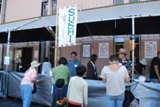 すし・・・・・・ほんとうは食べたかった。うどんも。
すし・・・・・・ほんとうは食べたかった。うどんも。
なつかしいやかん! と撮ったつもりがボケてました。ちょっと小ぶりのやかんでした。
これ(右)は古内東子でも水子でもなくて(お)菓子 です。奥では "Silent Auction" がひそやかに開かれています。
のぼりと山の感じが日本風。 あれ? エルセリートに山はないと言った前言はどうなる(いや、海岸沿いにはない)。
日本、日本しているかというとそうでもないです。日本のお祭りでよく見るような子供相手の射的の香具師の役を大きなこどもが演じたりしています(ちがうだる、それにたとえが日本)。
読めないでしょうが、ハンバーガーののぼりのむこうの照り焼きチキンもおいしいと評判なのですが、モーリちゃんたちも高くて食べられなかったと言ってました(ひぇ~、貧乏~)。
モーリちゃんの父は最初にひとしきりぐるぐるぐるぐると見たあと、モーリちゃんたちを置いて、そそくさと立ち去りました。誰に会うかわからんですし、れいこ先生とアポもなかったですし。
あとから聞いたら、やっぱりいろんな人が来ていて会ったようです。 モーリちゃんの父も最初に受付のところで知り合いの女の子に会ったのだけれど。
バザーというのは本来は宗教的な意味合いはないのでしょうけれど(ペルシア語だし、中東諸国のバザールを考えてみると)、"Christmas bazaar" とかなると「慈善市」的な含みがでてくるんじゃないかと思います。で、やはり教会と母校のための催しですから、少なくとも食べ物は、やっぱり donation 的というか、商売じゃないから逆に高めな感じがモーリちゃんの父はしました(貧乏人感覚では)。あとオークションも、最初のスタート額がけっこう高かったそうです、情報によると。
それでも、モーリちゃんたちがおみやげに買って帰ってきてくれたお菓子の楕円形のまんじゅう(5個5ドルって言っていたかな、まあ安いじゃん)は、なつかしく、いとおいしかったです。そして、もう一度マドさんの言葉を反復させていただくと、絆を感じたのでした。
September 23 standard form, expanded form, word form, short word form 算数の勉強 (2) Math Practice (2) [小学校と銀行]
September 23, 2008 (Tuesday)
今週の "spelling words" は先週までのふつうの英語の語彙とうってかわって、15個ぐらい算数の用語が並んでいて、それぞれ定義と例をあげたうえで理解し覚えねばならない。家族みんなで覚えよう、ということに月曜日に相談して、今日は残っていた "word form" "short word form" の確認をしたのでした。
だって、教科書のGlossary をヒントにして自分でdefinition を書いてね、というのが付帯的な算数の課題なのだが、グロサリーに "word form" も "short word form" もないんだもの。ちなみに "standard form" は "standard notation" として載っていて、同様に "expanded form" も "expanded notation" と教科書には書いてある。いろんな言い方しないでくり~!
手元の辞書にはnotation は《数学》で「記数法」としていますが、 "standard notation" は 《チェス》で「国際式記法 (=algebraic notation) 」としか載ってません。指し手の記録のために、盤の縦列を左から順にa, b, c,... h、横列を下から順に1, 2, 3, ... 8、にして座標式に表わす、ああ、これはモーリちゃんの父がむつかしいsudoku 問題を記録するときにやるやりかたと同じです。
standard notation [form] というのは、十進法で記述する一般的な数の記載法のことです。ただし慣用的にコンマが入るから、2,008 みたいな― The most familiar way of representing whole numbers [自然数], integers[整数], and decimals[小数=decimal fraction]. In standard notation, numbers are written using the base-ten place-value system [base-ten もリーダーズ英和辞典とかに載っていないようなのですが、けっきょく「十進法の」という意味です。そしてそれはdecimalなわけで、decimal fraction (fraction は分数) が小数なのは論理的にはわかるけれど、少なくとも日本人のおじさんの頭にはたいへんconfusing としかいいようがない]. For example, standard notation for two thousand eight is 2008 。
expanded notation [form] は、桁ごとの合計として数を表記する方法です― A way of writing a number as the sum of the values of each digit. For example, in expanded notation, 2008 is written 2000 +8。
だとすれば、word form というのは我が国の漢数字を使い、かつ万とか百とか十とか書くような表記に相当するものだろうな、と想像できるのですが、ふつうの辞書には載っていません。いっぽうでword 自体の形態、語形という意味で辞書学とかで使いそうだし、"form" って多義的すぎ、というか、ぼんやりすぎ。辞書には数学用語としては「形式」としか書いてないです。
で、今日検索しました。
また、小学生が全国こども悩み相談いや駆け込み寺的に質問を発していました(ひと月前、8月)。――
How Do You Write A Word Form Of 145,250? And Also A Short Word Form For This Number?
In math, how do you write these type of forms? This is for 4th grade math homework. 〔blurtit.com〕
それに対するふたつの回答の最初(女性)――
Best guess here would be that each letter of the alphabet is assigned a number, ex. A=1, b=2 etc.. That's what I remember. Go through your 145,250 and write the corresponding letters.
Not sure what a short word form is... Guess I am not smarter than a 4th grader!"
わけわかめの答えです。どこにもなんでも答えたがる人はいるようです(笑)。ちなみに最後の私って、「4年生よりおばか」は、テレビ番組の "Are You Smarter Than a 5th Grader?" (金曜8時 KTVU/FOX) を思いださせます。〔番組のHP <http://www.fox.com/areyousmarter/features/>〕
さいわい、すぐに別の回答者[男性)があらわれたようです。
One hundred forty-five thousand two hundred fifty.
Short word form is a combination of numbers and words:
145 thousand 250.
"word form" というのは、だから、身近な例としては、小切手に金額を書くときの形式なわけですね。しかしカンマとかハイフンとか細かい問題もあるような。上の例だと、ふたつとも thousand のあとにカンマが入りそうな気がする、formality の問題かもしれませんが。
そのあと、教科書の本のグロサリーをよく見たら、 "Number-and-word notation" という見出しで short word form と同じ数の記述法が書かれていました―― "A way of writing a number using a combination of numbers and words. For example, 27 billion is number-and-word notation for 27,000,000,000." ああ、なるほど、"27 billion" は「270億」「二七〇億」みたいな書き方と同じようなかんじで便利ということですね。
ところで、この回答者の"Short word form" のリンクを見ると、ついでにexpanded form の例として、次のように書かれています。
In expanded form or expanded notation, your number is written as: 4 x 100,000 + 7 x 10,000 + 4 x 1,000 + 1 x 100 + 3 x 10 + 6 x 1
expanded form は、教科書に載っている説明では、「365 を 300 + 60 + 5 と書く」としています。さらにexpand して3x100+ 6x10 + 1もexpanded form なのでしょうか。どっちでもいいのでしょうか。はっきりしてほしいものです。ぷんぷん。
それでは問題です。次のstandard form, expanded form, word form, short word form で書かれた数を4つの等しい値の数のグループに分けなさい。使わない記号もあります。
A. 8,687
B. 80,000 + 7,000 + 600 + 80
C. 80 thousand, 687
D. eighty-seven thousand, six hundred eighty
E. 86 thousand, 870
F. 80,687
G. eight thousand, six hundred eighty-seven
H. 80 thousand, 870
I. 86,870
J. 87,680
K. 8,000 + 600 + 80 + 7
L. eighty thousand, six hundred eighty-seven
M. 8 thousand, 687
N. 87 thousand, 680
O. 80,000 + 600 + 80 + 7
元は "Peas in a Pod" というタイトルの問題で、豆のさやに豆を入れるというかたちで「現実」と切り結ぶ(?)算数問題です―― eduspace.com の。
74124_CMU02L09 pp2 (PDF) 〔正解つき〕
「同じ豆のさやの豆」というのは「うりふたつ」みたいな意味で慣用句がありますねー
"(as) like [alike] as (two) peas in a pod"
| "Two Peas in a Pod" Candle in Ivy Print Gift Box (Set of 4) | |
| $6.00 Ribbon Angel | |
カリフォルニア時間9月24日8時追記
すいません、改行なしになって読めないところがありました。なおしました。
October 15 Magnitude Estimate――日々の算数の勉強 (4) Daily Math Practice (4) [小学校と銀行]
October 15, 2008 (Wednesday)
以下は数学と英語と両方好きでかつヒマという方以外は読まないほうがよいような内容です。
その3は執筆中(笑)。
magnitude estimate
estimate は概算、推定(値)、見積もりである。それは概ね推定しなくてもわかる。An estimate is an answer that should be close to an exact answer. しかーし――いきなり magnitude estimate で以下を出せ、とか言われてもわかりませんがな。
【問題―◆For each problem, make a magnitude estimate. ◆Circle the appropriate box. Do not solve the problem. ◆Then choose 3 problems to solve. Show your work on the grid. (それぞれの問いに magnitude estimate を行なえ。適切なボックスを丸で囲め。問題は解いてはいけない。以下略)とあって、1. 8 * 19 2. 155 *6 3. 37 *58 4. 5 * 4.2 5. 9.3 * 2.8 と5問並んでいてそれぞれの下に 10s, 100s, 1,000s, 10,000s のボックスが書かれています(* は× です。印刷やWEBでは* が主流みたい)。――実物を見たいという奇特な方がいらっしゃるなら、くそ重いpdf.ですが、以下がWEBにあります―Unit2_000.pdf のStudy Link 2-8】
しょうがなく教科書を勉強すると概算の方法としていくつかあがっていた。
a) leading-digit estimation: A way to estimate in which the left-most, nonzero digit in a number is not changed, but all other digits are replaced by zeros. For example, to estimate 432 + 76, use the leading-digit estimates 400 and 70: 400 + 70 = 470. 訳すのがめんどくさいくらいの英語なのでお訳御免ですが、これは切り捨てですね。それも第何位をとか選択肢はなく、最初の桁だけ残してすっぱり落とす。
b) rounding: To round is to adjust a number to make it easier to work with or to make it better reflect the level of precision of the data. Often numbers are rounded to the nearest mulitiple of 10, 100, 1000, and so on. For example, 12964 rounded to the nearest thousand is 13,000. これは日本語で俗にいう(ほんとに言うのだろうか)「まるめる」という動詞ですな。やっていることは四捨五入のようですが。そしてこの場合はどのクライでround するかが指定されることになります。以下に例をあげます。なんでこんなまだるっこしいステップを踏まねばならんのでしょう。3番目の例が等距離で中間の5ですけど、五入ですね(赤字部分に該当)。
b1. Round 4,538 to the nearest hundred → 4,500 [Step 1: Find the digit in the place you are rounding to → 4,538. Step2: Rewrite the number, replacing all digits to the right of this digit with zeros. (This is the lower number) → 4,500. Step3: Add 1 to the digit in the place you are rounding to. If the sum is 10, write 0 and add 1 to the digit to its left. (This is the higher number) → 4,600. Step 4: Is the number you are rounding closer to the lower number or to the higher number? → lower number. Step 5: Round to the closer of the two numbers. If it is halfway between the lower and the higher number, round to the higher number. → 4,500]
b2. Round 3.573 to the nearest tenth [tenth は10分の1 だから小数第1位] → 3.600 = 3.6 [Step 1: 3.573. Step 2: 3.500. Step 3: 3.600. Step 4: higher number. Step 5: 3.600 = 3.6]
b3. Round 5,295 to the nearest ten → 5,300 [Step 1: 5,295. Step 2: 5,290. Step 3: 5,300. Step 4: halfway between. Step 5: 5,300]
c) interval estimate: An estimate that places an unknown quantity in a range. For example, an interval estimate of a person's weight might be "between 100 and 110 pounds." これはただ推定しているだけじゃないのかと思うのですが、推定範囲を限定するということに意味があるのでしょうね。なんか論理的にはカテゴリーが違う気がする(気のせいかも)。これは英和辞典にも珍しく載っており、《統計》区間推定 ⇒interval estimation による推定値、とか書いてあります。interval estimation を見ると同じく「区間推定」と書いてあるのですけど(笑)。ま、estimation という行為の結果がestimate という関係ですか。
d) magnitude estimate: これが問題の推定です。本文での説明――"One kind of rough estimate is called a magnitude estimate. When making a magnitude estimate, ask yourself: 'Is the answer in the tens? In the hundreds? In the thousands?' and so on. You can use magnitude estimate to check answer or to judge whether information you read or hear makes sense" (Everyday Mathematics 250). 答えが何十か何百か何千になるかを考えて、実際の答えがあっているか、あるいは目の前の情報がまちがってないかを判断するのに使うと。グロサリーでの説明―― A rough estimate. A magnitude estimate tells whether an answer should be in the tens, hundreds, thousands, ten-thousands, and so on. グロサリーでは1万まで増えてるだけやん。わからんのは、どのようにやるか、です。
次のouronlineschools.org のページは、説明は同じだけれど、具体的なプロセスの記述がありました。――
- A Magnitude Estimate is a very rough estimate that answers the question:
Is
the solution [solution = answer] in 1s? 10s? 1,000s ? 10,000s?
- How to make a magnitude estimate:
1. Round the numbers to the nearest 1, or 10, or 100, etc.
2. Make the calculation.
3.
Determine if the solution is in 1s, 10s, 100, 1,000s, etc.
- For example:
Make a magnitude estimate for 356 * 17:
1. Round the 356 to the nearest 100: 400.
2. Round the 17 to the nearest 10: 20.
3. Multiply the estimates: 400 * 20 = 8,000
4. The solution of 356 * 17 is in the 1,000s.
5. To check, the actual solution is: 6,052
- Another example:
Make a magnitude estimate for 24.8 * .7:
1. Round the 24.8 to the nearest 10: 25
2. Round the .7 to the nearest 1: 1
3. Multiply the estimates: 25 * 1 = 25
4. The solution of 24.8 * .7 is in the 10s.
5. To check, the actual solution is: 17.36
例1では、356 × 17 を、356をnearest 100の400に、17 をnearest 10 の20にして、400 × 20 =8,000、答えは数千だなーとestimateするわけです。例2 では24.8 × 0.7。それが25 × 1 になって答えは数十だなあと。そして上の "How To" のところにあるように "round" してますね。
しかし、わけがわからんのは、なるほど小数だから24.8 を25 に、0.7 を1にするのは有意味に見えるけれど、じゃあ整数だったらどうなるねん、という疑問がフツフツと沸いてくるわけです。たとえば17.3 × 0.7 だったら17 × 1にするのか、それとも20 x 1 にするのか? "Round the numbers to the nearest 1, or 10, or 100, etc."というのはどの位を四捨五入するのか指定がないわけです。あるいは 24.8 × 27.8 だったら25 × 28にするのでしょうか? 25 × 30 にするのでしょうか? 20 × 30 にするのでしょうか? 宿題でいうと1番の8 × 19 は8 × 20 でよいのか、それとも10 × 20なのか? 2番の 155 × 6 は、160 × 6 なのか、 200 × 6 なのか、200 × 10 なのか? ネライがアバウトに桁を知るということなのだからなるたけ簡単な計算がいいはずですが、160 × 6 以外は 1000s になってしまうのだけれど・・・・・・。
で、さらにあれこれ調べ、教科書もさらに読んだのですが、どうやらmultitude estimate というのは、estimation について総括的に学ぶ前から、計算に先立つものとして推奨されているものだということがわかりました。
さらにいくつか例を並べます。――
(1) 15.2 * 3.6 = ? → Round 15.2 to 20 and 3.6 to 4. Since 20 * 4 = 80, the product will be in the tens. (In the tens means between 10 and 100.)
(2) 3.27*0.8 = ? → Round 3.27 to 3 and 0.8 to 1. Since 3 * 1 = 3, the product will be in the ones. (In the ones means between 1 and 10.)
(3) 34.5 * 2.05 = ? → Make a magnitude estimate. 34.5 * 2.05 ≒ 35 * 2 =70. The product will be in the tens. 〔≒は丸い二重波線が使われています〕
(4) 73.4 * 10.5 = ? → Make a magnitude estimate. "A good magnitude estimate is 73.4 * 10.5 ≒73 * 10 = 730. The product, 770.70, is close to the estimate of 730."
(5) 97.24 / 26 = ? → Make a magnitude estimate. Since 26 is close to 25 and 97.24 is close to 100, the answer is 97.24 / 26 will be close to the answer to 100 / 25. Since 100 / 25 = 4, the answer to 97.24 / 26 should be in the ones.
(4) の例では"good" magnitude estimate として質的な差がmagnitude estimates にあることが示唆されています。つまりアバウトにふつうに考えれば70 × 10 で700でしょう。そしてそれはハズレてはいないし、元来の目的とされるどのクライに位置するか、何桁くらいになるか、というのではオッケーなはずなのに。そして、(5) は割り算の例ですけれど、26.2 とか25.5 とか小数以下があるわけではないのに26を30ではなく25に "round" し、magnitude estimate をしている。これはルール破りじゃないんすか? (あ、いま入ったクラスメートからの情報によると、なんか2. 155 * 6 の 6は10にするというふうに教室では言われたという・・・・・・そのときに155はそのまま残すというのなら合理性はありますけど。)
しかし、どうやらルールがないのがmagnitude estimate なのかもしれない、と思い到りました。計算ラクならいいんじゃないの、みたいな。でもこの時点(実際の計算前)で頭使いすぎるるのはよくないけど。まあ、確かに本来適当にこんなもんだろうと目安がつけばいいのだろうから、ラクが一番だと思うのですが、ラクにもいろいろあるのが数の結びつきの世界であり、つい頭を使ってしまうのが人間の欲望というものであり。あと、次のような注も見つかりました。――
Note: Sometimes a magnitude estimate is one the "borderline" and you need be more careful. For example, a magnitude estimate for 2,890 / 3.4 is 3,000 / 3 = 1,000. This answer is "in the thousands." But the exact answer may be "in the hundreds." You should place the de[c]imal point so that the answer is close to 1,000. Since 2,890 / 34 = 85, you should attach one zero, followed by a decimal point: 2,890 / 3.4 = 850. (p. 42)
誤植も見つけちゃったw
どうも日々のマスは、日常生活で使われる算数や幾何という姿勢が強く、estimation についてもそういうところから力を入れているような感じもします。あるいは統計を読むリタラシーみたいな視点。たとえば、つぎのような論文(計算機を使うのではなくて頭でestimate する技を教えるべしという)が20年も前に書かれていたりして――
James A. Levin, "Estimation techniques for arithmetic: Everyday math and mathematics instruction" Educational Studies in Mathematics 12.4 (1981): 421-34.
Abstract Recent advances in the way that adults perform computation in our society require reconsideration of the assumptions underlying current elementary mathematics instruction. The widespread use of calculators and computers for situations requiring precise calculation removes much of the motivation for teaching the current addition, subtraction, multiplication, and division algorithms. Yet precisely this use of computing technology now puts a premium on the exercise of estimation techniques for verifying the reasonableness of computations. These techniques, especially those that can be used
mentally
(without the use of any external tools), have been used informally for years, but never formalized for instruction. This paper discusses a range of estimation techniques, and presents in detail a series of mental estimation procedures based on the concepts of measurement and real numbers rather than on counting and integers. A set of techniques for teaching these procedures is described. These estimation techniques are evaluated against the multiple functions that elementary mathematics instruction needs to serve.
それにしても、もっとはっきり子供にも大人にもわかるように説明してもらいたいもんだわさ。ぷんぷん。

November 6 エラー・ペニーズ Error Pennies――ペニーズ・フロム・へヴン (2) [小学校と銀行]
November 06, 2008 (Thursday)
昨日の50年以上前の古いペニー(wheat penny とか wheat leaf penny と呼ばれる)がいくらか調べてみたら、1ドルくらいで売られているようです。まあ、それでも100倍ですから、ギザうれしいような(ギザじゃないっつーの)。
モーリちゃんの小学校の日々のマスの教科書Everyday Mathematics には、通常の算数の勉強を超えて、つまるところ現実の生活に関わりのある数字や幾何という姿勢で、さまざまな図版やデータが挿入されています。たとえば建築について("The Empire State Building, at 381 meters (1,250 ft), held the height record more than 40 years."; "The Parthenon in Athens, Greece was built around the time of Pythagoras. The ratio 2:3 and its square, 4:9 can be seen in its construction." etc.)、たとえば航海について("Navigators know that the moon orbits the earth every 29.5 days. It also rises each night about 48 minutes later at a different point. By tracking the location of the rising and setting moon, they can use it to steer by." etc.")、たとえば宇宙について("Light travels 186,000 miles every second. In one year, light can travel nearly 6 trillion miles."; "At about 240,000 miles away, your light beam will take you there [to the moon] in about 1.3 seconds."; "It [the North Star] is 300 light-years from the earth, about 70 times father away than the closest star, Proxima Centauri." etc.)。さらに巻末には "American Tour" と題する、60ページ近い資料のセクションがあって、1600年のネイティヴ・アメリカンの人口密度の地図とか、1790年の人種の割合とか、外国生まれのアメリカ人人口の推移とか、ほとんど社会科のデータが入り込んでいます(実は日々のジオの教科書よりこっちのほうが詳しいんじゃないか、とさえひそかに思ったりもする)。
それで、287から292ページは "American Currency" という見出しの "Mathematic...Every Day" のコーナーのひとつで、お金の話が、なるたけ数字に関わるようなかたちで、歴史的に記述されています。スペイン金貨を割って使った "Pieces of Eight" 〔つぎのHistory Lives のページの写真と解説を参照 <http://www.historylives.com/everydaylife.htm>〕から"One Third of a Dollar" 紙幣という独立戦争時の仮のお札〔つぎのThe Horse Solder - Currency のカタログを参照 <http://www.horsesoldier.com/catalog/c0017.html>〕とかの話から、現代のお札や硬貨、そしてクレジットカードなどに話はわたっています(1ドル紙幣は約22か月使われる、とか、ヘー、という話があれこれある)。そして、その2ページ目のまんなかに、次の写真が載っていたのを思い出して、さっきスキャンしました――
いちばん上に書かれているように、アメリカ合衆国の造幣局は現在1日に32 million というから3200万個ですか、硬貨を鋳造しておるのだそうです(ちなみに、紙幣は、1日あたり 37 million枚、額にして$696 million 発行しておるそうです)〔照合はしていませんが、日本語のウィキペディアの「アメリカ合衆国造幣局の硬貨発行枚数一覧」も参照〕。で、ついでに入れちゃった、1792年に銀貨がつくられたときにジョージ・ワシントンは家にある銀製品を寄付した(銀が稀少だったから)というエピソードはまあ、つっこむ気はないです。で、右下のおじさんです。この人は、画面ではよくわからないかもしれませんが、ラコステのポロシャツを着ているんですね(それがなにか・・・・・・はい、けっこうです)。そしてルーペを手にして、1セント玉、つまりペニー貨をチェックしています。これは現在国内に・・・・・・ウィキペディアの「アメリカ合衆国造幣局」には「本部は、ペンシルバニア州フィラデルフィアのフィラデルフィア造幣局に置かれている」と書いてあるけれど、US Mint のホームページを見ると、United States Mint Headquarters は Washington, D. C. となっています <http://www.usmint.gov/about_the_mint/index.cfm?action=mint_facilities>、よくわかりませんが、ともかくフィラデルフィアやデンヴァーやサンフランシスコや、いくつかの造幣局で硬貨がつくられておって、これがどこのMint かはわかりません。WEB で同じくペニーズをチェックしている画像は、次の、貨幣鋳造のプロセスを説明するページに見つかります(ここでは女性が、固定式のルーペでチェックしている画像が入っています)。
From "Blank" to "Bank" - How Coins Are Made <http://www.pmgcollections.com/coin-production.shtml>
あと、造幣局自身がスライドショーとビデオの2本立てでヴァーチャル・ツアーと称するページを開いているのですね――
The United States Mint Virtual Tours <http://www.usmint.gov/mint_tours/index.cfm?flash=yes&action=vtShell>
これの、48枚からなるスライドショーの4枚目の地図を見ると、Denver, Colorado; Philadelphia, Pennsylvania; San Francisco, California; West Point, New York; Fort Knox, Kentucky が、本部のWashington, D.C. を入れてきれいに弧を描くようにアメリカのまんなかを東西に横断しているのがわかりました。あとギザって"reeded" っていうんですね、英語では(38枚目)。そして42枚目から44枚目まで、inspectionについて書かれていて、それは一部そのまま上の"How Coins Are Made" に引かれているようですが、――
"Inspecting a freshly minted penny." The coins fill a collection box called a trap. An inspector checks the coins to see if they meet United States Mint quality standards.
Coins are compared to both visual and fill standards. Next, critical Statistical Process Control (SPC) and capability quality data are entered into the United States Mint's data collection system to track key processes.
"The waffler." If an error is spotted, coins in the collection box are scrapped and sent to coin destruction machines called wafflers. These machines use two high-pressure rollers to impress a ridged pattern into the metal. Distorted and mutilated, the metal loses denomination value. However, it is recycled for future use.
"Pennies fall from the collection box to a conveyor belt." If the coins pass inspection, the operator pulls the trap’s lever. This discharges the coins onto a conveyor belt that transports them to the counting and bagging area.
ということで、厳しい検査を通って世の中にでてくるペニーたちですけれども、なかなか変わったペニーもあるようで、いったいどのようにして現われたのか、とちょっと、フリークを見るような気持ちになって、びっくりした画像(BGM はやっぱり "Pennies from Heaven") ――
"PENNIES FROM HEAVEN - I mean ERROR Pennies from the MINT" (1:31) posted by "postingmyvids" on May 12, 2007: "These pennies are rarely seen by the public, and even harder to get. Details are given at end of show - ENJOY
Thanks to YouTube for the use of the song "Pennies From Heaven" Sung by Louis Prima"
業者の宣伝をする気はありませんが、現在 "Authentic Off Center Error Coins" をfeature 中で解説もあり― NowFeaturedCom
"ERROR COINS, Coin errors explained Page" <http://www.nowfeatured.com/errorexplain.html>
なんか精密度に欠けているような気がします。もっとも、上のページの解説を読むと、"[S]ince the detection equipment is much more sophisticated now, it is becoming more difficult to obtain these coins."とか "Not only is it scarce it is becoming nearly impossible to obtain now that the mints have better detection equipment." とか書いてあって、探知装置(?)(機械?)の性能が向上したので現在は入手困難となっていると書かれていますけれど。内部の人間がもちだしているとかないんでしょうか。
送料無料で19.99ドルだそうです。日本だと偽造or変形硬貨をもっているだけでマズイのでしょうが、アメリカは硬貨に関しては大らかなのかも(ウィキペディアのどこぞに書いてあるように、硬貨をつぶして記念にするような商売もあるみたいなので)。
------------------------------------------------------------------------------
硬貨製造→ アメリカ造幣局 The United States Mint Home <http://www.usmint.gov/>
紙幣製造→ アメリカ印刷局 US Bureau of Engraving and Printing <http://www.moneyfactory.gov/>
October 13 今日もマスの勉強でございマス Everyday Mathematics [小学校と銀行]
October 13, 2008 (Monday)
モーリちゃんの小学校5年の今日の宿題に "Puzzling Patterns" と題するページがあって、Professor Pattern prepared these puzzling patterns for you to ponder. (パタン教授が以下のパズル的パタンを諸君がポンダーするためにプリペアしたよ)と P 音の頭韻を畳み重ねて問いかけています(パタン先生はやりすぎだっちゅーの)。パタンに当てはまる数字を続けて3つ書け(Write the next three numbers in the pattern.) ということで、4, 8, 16, 32、それと3, 15, 75, 375、そして2, 5, 9, 14 と3問あり、それぞれ答えの数字のあとに Describe the pattern. という問いがオマケでくっついていて、モーリちゃんもそうだけれどモーリちゃんの父もとてもイヤな文章題になっているわけです。2つ目までは、ただ x2 と x5だから、まあ適当に文章にはできる。しかし2, 5, 9, 14 はなんだ。差(difference) が1ずつ大きくなっていく。どう言えばいいのでしょう。
適当に検索すると、たとえば次のようなQ&Aが出てきました。――
Q: |
|
これは askvill (by amazon) というページ <http://askville.amazon.com/Mensa-problem-solving-%2311/AnswerViewer.do?requestId=3005521>。"mensa" というのは、"A Beautiful Mind IQ Test" というフラッシュページです(おひまな方は頭の体操にどうぞ <http://www.abeautifulmind.com/games/iq_test/mensa.swf>)。 その11問目に、ただ次の数を求めよ、ということで出てくる、それの質問です(頭が美しくないのでしょうか)。回答――①"2 5 9 14 20 27 / 5-2=3, 9-5=4, 14-9=5, 20-14=6, 27-20=7" [. . .] ③"The increase from 2 to 5 is 3 /The increase from 5 to 9 is 4 /The increase from 9 to 14 is 5 /The increase from 14 to 20 is 6 /The increase from 20 to 27 is 7" ④"for each iteration add 2 + n (the iteration number) to the current result. It's recursive. /To find the nth iteration: /A1 = 2 /An = An-1 + n + 2" ⑤"Starting at 2 add 3/to the answer add 1 plus the previous value added."
まあ、答を求めているだけなのですが、説明的なのは④と⑤で、④は現在の答にn度目かのn+2を足す、みたいなややこしい答え、⑤は2で始めて3を足し、答に前の値と1を足す、みたいな感じでしょうか。なんか英語がこれで論理的にOKなのだろうか? とう感じ。
Algebra 1 Online Sample Lesson <http://www.oakmeadow.com/curriculum/overviews/algebra1_sample.pdf >はあれこれ書いてあるが、具体的な記述の文章はなく。
Algebra/Geometry Institute Summer 2003 <http://209.85.173.104/search?q=cache:WjPf1It7dw4J:www.deltastate.edu/docs/math/lp1gloria.pdf+%222,+5,+9,+14,+20,+27%22+numbers+in+the+pattern&hl=ja&ct=clnk&cd=2&gl=jp&client=firefox-a> (http://www.deltastate.edu/docs/math/lp1gloria.pdf のHTMLバージョン) は下のような図式がありました。――
Example /Find the next two terms in the sequence below.
2, 5, 9, 14, 20
Solution
Find the first differences
2 5 9 14 20
\ / \ / \ / \ /
3 4 5 6
Since the first differences are not constant, find the second differences.
2 5 9 14 20
\ / \ / \ / \ /
3 4 5 6
\ / \ / \ /
1 1 1
The second differences are a constant 1. Use the constant second
difference to extend the sequence of first differences.
2 5 9 14 20
\ / \ / \ / \ /
3 4 5 6 7 8
\ / \ / \ / \ / \ /
1 1 1 1 1
2 5 9 14 20 27 35
\ / \ /
7 8
fifth term sixth term
↓ ↓
20+7=27 27+8=35
↓ ↓sixth term seventh term
こんな複雑な話だったの。まあ1が並ぶのはビューティフルですが。
ちょっと違うけれど、こういうQ&A もあった(YahooAnswers <http://answers.yahoo.com/question/index?qid=20080903142305AAmYN9H>)――
Math help!? Try to find the next TWO numbers in the pattern!?
Can you please figure out these patterns and predict the next TWO terms.
18,46,94,63,52,61
O,T,T,F,F,S,S,E,N
4,8,61,221,244,884
6,8,5,10,3,14,1
B,0,C,2,D,0,E,3,F,3,G
2,3,6,1,8,6,8,4,8,4,8,3,2,3,2,3
AEFHIKLMNTVWBCDGJOPQRSU
where do the X,Y, and Z go?I know there a lot of problems.
please tell me which problem you solve!
For the first one square the first number and reverse the number:
4² = 16 = 61
5² = 25 = 52
6² = 36 = 63
7² = 49 = 94
8² = 64 = 46
9 ² = 81 = 18
For the second one, the next two are T and E. The letters are the start of the numbers, for example, 1 starts with O, 2 starts with T and so one and so forth.
For the third one, double the term and reverse the digits. The next are 8672 and 24371.
For the fifth one, how many free ends the letter has. The next are 2 and H.




